Topic letter 13
Changing mindsets, changing results
A neuropsychological perspective
1. Introduction
We live in the century of knowledge. Our society prospers because it can rely on strong knowledge intensive organizations. We owe this position due to the fact that we have the ability to think. This topic letter focuses on the statement Einstein once formulated: "You cannot solve a problem within the mental framework that is used to define it." Both the problem and the solution are created out of building blocks from our frame of reference, the mental models. If we learn to play with these models, we can discover new possibilities to solve problems more easily. Besides that, the communication and cooperation with others will improve, if we acknowledge that everybody creates his own reality. The more knowledge intensive the work is, the more beneficial changing mindsets can be.
2. The sensory perception
If we look out of the window it is difficult to imagine that this perception is a learned process and different for everybody. What we see is our reality and we seldom challenge our way of perceiving. During our live our perception has gone through enormous learning processes, without which we would not be able to perceive anything. Thanks through recent breakthroughs in the medical field, there are people now who have not been able to see anything until they were forty years old. They have been suffering from a serious form of cataract and their eyes have recently been lasered. You would expect that these people finally can see their friends and family, but the opposite is true. They have enormous problems in digesting all the signals that are send by the eyes to the brain. After some time they perceive the world like the paintings of Vincent van Gogh and slowly they start to recognize faces. For a person who has been able to see all his life, it is difficult to imagine what somebody sees who has been blind for so many years. It is even more difficult to realize that our own way of seeing probably also differs from what other people see. In order to explain this, a short guided tour through the perception process.
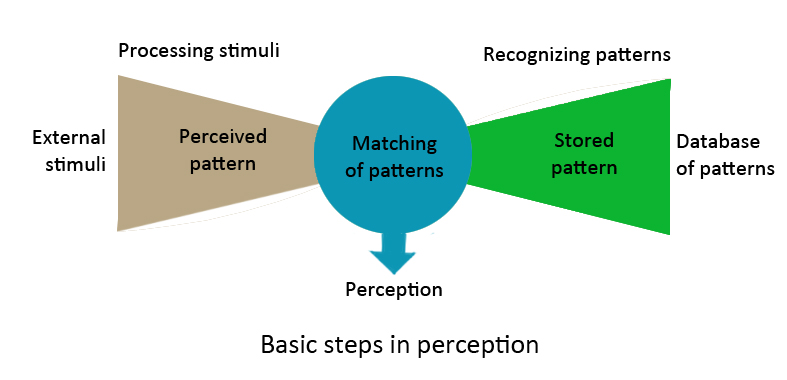 If we entangle the perception, we can distinguish two main processes: the processing of stimuli and the recognition. The processing of stimuli registers and transforms external stimuli into a neural representation of the outside world somewhere in the brain. The recognition is a process that gives meaning to this internal representation. The processing of stimuli is characterized by an enormous reduction of stimuli, by a factor of ten million. This process ends with the detection of sensory building blocks which assembled create patterns. This process is mostly inherent and probably leads in different people to the simular results.
If we entangle the perception, we can distinguish two main processes: the processing of stimuli and the recognition. The processing of stimuli registers and transforms external stimuli into a neural representation of the outside world somewhere in the brain. The recognition is a process that gives meaning to this internal representation. The processing of stimuli is characterized by an enormous reduction of stimuli, by a factor of ten million. This process ends with the detection of sensory building blocks which assembled create patterns. This process is mostly inherent and probably leads in different people to the simular results.
After finishing the neural representation, we still do not know what we are perceiving. The patterns do not have a meaning yet. In order to get this, the patterns are offered to a sort of virtual market in the brain. On this market, the recognition process starts which is working according the principles of association. One party offers patterns, the other party searches in the archives whether that combination of patterns has been detected and archived before. The purpose is to create a match which will lead to the awareness that something is being perceived. A 90% correct match (e.g. an unfamiliar face) also leads to a recognition and this new pattern might be archived as an addition to the stored material. In this way, the archive slowly expands. A perception can be defined as a recognition of a stored pattern. Without stored patterns, there can be no match. In fact we can never perceive more than is stored in our archives. So we only perceive what we know. If the pattern does not lead to a match, it will disappear without being noticed. The marketplace needs his attention to process new patterns. Patterns which cannot be recognized, will not be noticed and also stored. They are gone forever.
Perception is literary a "re-cognition", the "renewed cognition" of an existing pattern. Due to the fact the everybody has had different experiences, the archives of different people are filled with different patterns and the perception will differ from person to person.
Everybody who has had the opportunity to work with Apple iPhoto can recognize both perception processes in the functionality of this program. All steps from making a picture with the digital camera until the projection of the picture on the screen, can be seen as the processing of stimuli ending in an internal reproduction of the image. The computer reproduces, but does not add any meaning. Apple iPhoto is programmed to also do some elementary aspects of giving meaning the stimuli. The first step is programmed and leads to extracting faces out of all stored photo's. The second aspect is that iPhoto asks to give a certain portrait a name. As soon as the name is typed (e.g. the name of a good friend), iPhoto analyses 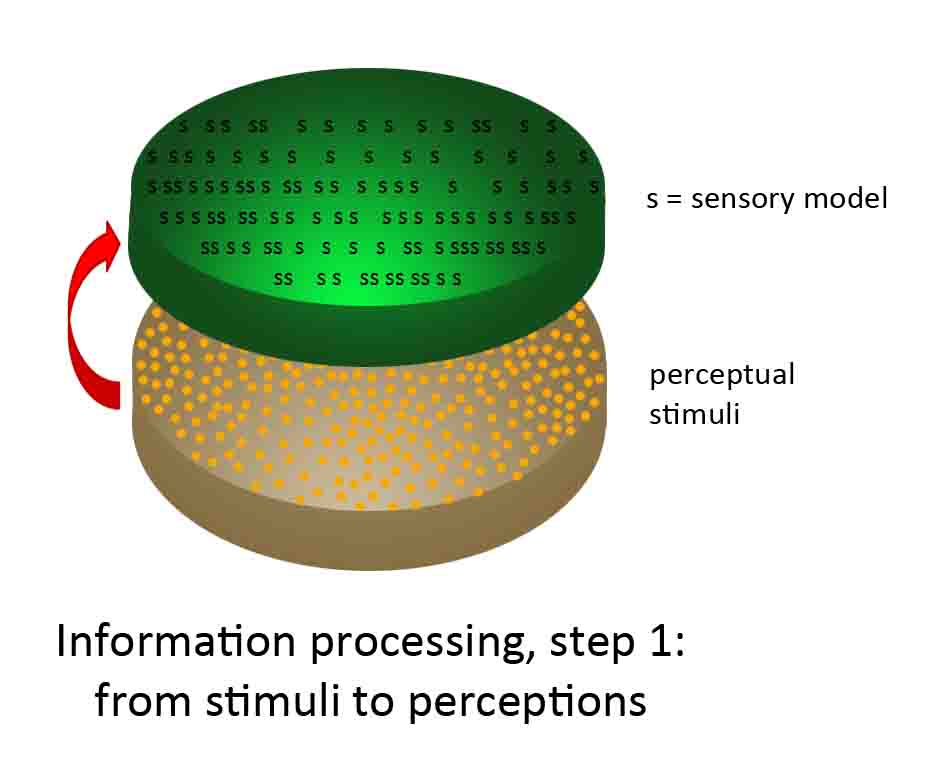 the complete database and tries to recognize all photos which contain your friend. If the program works well, it delivers a map with all pictures on which your friend has been detected. This is clearly a process that adds meaning to a collection of digital stimuli. In this century of knowledge, programs like this are the first on the market who try to integrate brain functions. In the coming ten years, also the next step in information processing, the integration of recognitions, will be integrated into software.
the complete database and tries to recognize all photos which contain your friend. If the program works well, it delivers a map with all pictures on which your friend has been detected. This is clearly a process that adds meaning to a collection of digital stimuli. In this century of knowledge, programs like this are the first on the market who try to integrate brain functions. In the coming ten years, also the next step in information processing, the integration of recognitions, will be integrated into software.
Summarizing, sensory perception consists out of processing external stimuli which, after filtering, are compared with stored patterns. A match leads to recognition: the actual perception. Without a properly filled database, there can be no recognition and no perception. All perception is the result of a learning process. If we have not learned to perceive something, the internal signals will fade out without a match and without a perception. In layman's terms we call this: "he did not get it!"
3. The mental perception
The sensory perception generates images about what's happening around us. The mental perception tries to understand these images and to put them in perspective. There are 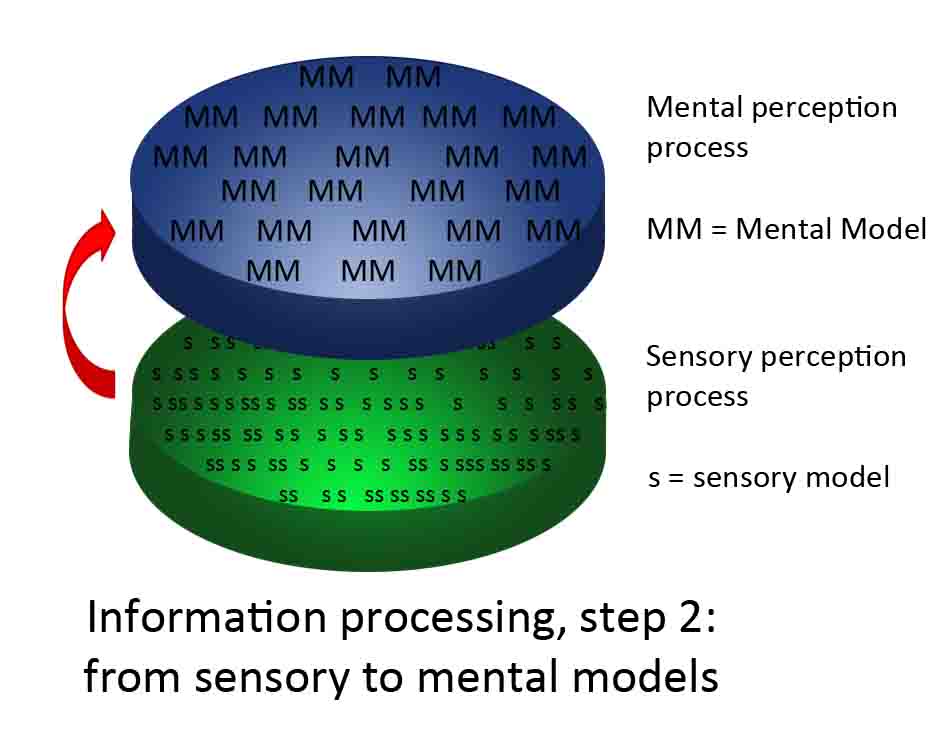 several parallels between the sensory and the mental perception process. Both are organized around building blocks. In the mental perception these are called mental models. Both processes are based on matches with archived information. A match in the mental perception can be seen as an interpretation (aha, this means …). A picture of a group of people can be interpreted as a party or as a meeting at work, depending on other mental models perceived while looking at that picture. These interpretations together create "the reality", which is a mental construct of what we think is true. "To realize" literary means "to take for real". Finally, both processes are a result of a learning process, which means that the way we perceive reality is personal and unique. Each person realizes that there is a reality, but strictly speaking, it is not thé reality but his/her reality. A reality always belongs to somebody.
several parallels between the sensory and the mental perception process. Both are organized around building blocks. In the mental perception these are called mental models. Both processes are based on matches with archived information. A match in the mental perception can be seen as an interpretation (aha, this means …). A picture of a group of people can be interpreted as a party or as a meeting at work, depending on other mental models perceived while looking at that picture. These interpretations together create "the reality", which is a mental construct of what we think is true. "To realize" literary means "to take for real". Finally, both processes are a result of a learning process, which means that the way we perceive reality is personal and unique. Each person realizes that there is a reality, but strictly speaking, it is not thé reality but his/her reality. A reality always belongs to somebody.
4. Frame of reference
For man it is very important to know how the world is organized. During the evolution, control of the environment has been a critical success factor in surviving. On a mental level, control is created by having a theory about reality. Such a theory exists on the level of the mental models (did I understand that well?) or on the level of a broader interaction between mental models (what conclusion can I draw?). Such a broader interaction between mental models a called a frame of reference.
An example of a high level frame of reference is the innovative ability of an organization. The concept innovation can be defined in many ways. Does the definition limit itself to developing new products, using new expertise of finding new markets, or does it also involve a new way of organizing the internal processes like marketing, logistics or finance? If a board of an organization makes a statement that they want to increase the level of innovation, probably there are as many definitions of the word innovation than there are board members. This diversity with a frame of reference between people can both have advantages and disadvantages, which I will discuss later in this letter.
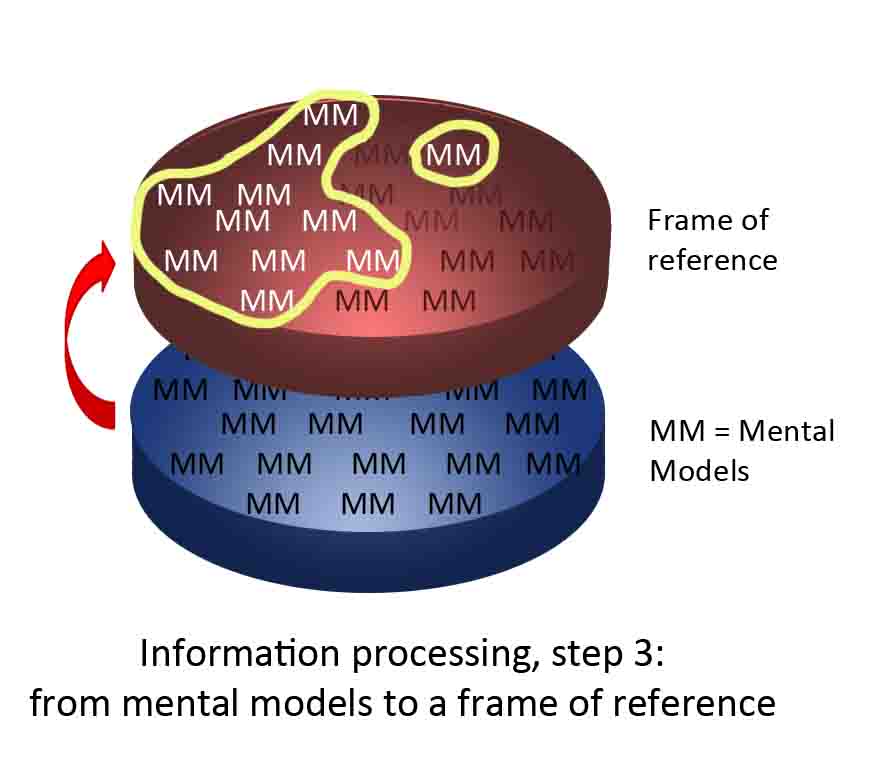 In the illustration you can see that a frame of reference consists out of a set of mental models. Some of the present mental models are not included. A frame of reference is always a selection of actual mental models (e.g. some aspects of an organization are included when thinking about innovation, others not). So models can be included or excluded from the selection. In the illustration, one mental model is involved but isolated, symbolizing a "problem".
In the illustration you can see that a frame of reference consists out of a set of mental models. Some of the present mental models are not included. A frame of reference is always a selection of actual mental models (e.g. some aspects of an organization are included when thinking about innovation, others not). So models can be included or excluded from the selection. In the illustration, one mental model is involved but isolated, symbolizing a "problem".
Thinking in terms of models is powerful. It helps us to think about things which are not here and now and even never have existed. In our imagination we can create virtual simulations of situations which might happen and we can safely experiment what to do in which situation. The downside is that there are also problems involved using this frame of reference. One arises inside the person and the other one between persons. The first one, the internal problem, arises when the used frame of reference seems to be unsuitable to solve a particular problem. It is difficult for a person to free himself from his own mental models, so he is captured by the captivation of them. The second one, the interpersonal problem, arises when a highly intellectual colleague sees brilliant opportunities, but is not able to sell these ideas to his direct environment, because they do not understand him. I want to elaborate on both of these problems.
5. The frame of reference encloses the problem and blocks the solution
The free work memory in the prefrontal cortex has a limited capacity and allows only a minor amount of models (referring to perceptions, memories, associations en thoughts) to be involved. Dominant models influence which models are allowed to participate. Police officers are sometimes blamed for having a tunnel vision while doing an investigation. In fact, everybody can be blamed for having tunnel visions.
A frame of reference helps us to understand the world, but in this process, many mental models have to be neglected. That selection is needed but can be very effective. In these cases, the frame of reference helps to solve all the topics that have to be dealt with. Sometimes however, crucial mental models can be blocked because they do not fit in the actual frame of reference. Due to this blocking, several options to understand the situation or to act, are not recognized. In this case there is a lack of options and a certain problem cannot be solved. Other people, with their own different frames of reference, make different selections and might see a solution for a particular problem immediately, because their selection of mental models contains a solution which might work. A "problem" can be seen as a direct result of the own frame of reference. This frame is a great help in defining and understanding the situation, but at the same time blocks available solutions, because they were not included in the selection of mental models. This is the reason why Einstein states that a problem cannot be solved within the frame of reference that has created it. The problem is a result of the frame of reference. Changing this frame can either lead to a new perspective in which the problem no longer exists or can lead to new options in which the problem can be solved. The famous E=MC2 was discovered at the moment that Einstein opened his frame of reference for the model that energy can transform into mass and vice versa. Kekulé discovered the structure of benzene at the moment that he opened his frame of reference accepting that molecules not only can be organized in a row but also in a circular structure.
6. Changing the frame of reference
The philosopher Cornelis (1997) defined a frame of reference as a hardened image of reality. Because it is hardened, it helps to get a grip on reality, but at the same time, it lags behind the changing facts. For Cornelis learning means melting a frame of reference, changing it and harden it in a new construction. Fortunately we can learn, incidentally we can change a frame of reference even very easy. An eye-opener is an insight that suddenly makes a series of incomprehensible facts to something very comprehensible. It is a good example of how frames of reference can change. An eye-opener shows that if all the mental models are present and that a shift in perspective can lead to a completely new insight, just by rearranging the models or adding one. This new image of reality can look so logical, that we sometimes wonder why we have not seen this before.
But how can we change a frame of reference via a conscious way if we have a problem? In general, the biggest problem in changing frames is that we are hardly aware of the fact that we have them. frames are an integral and unconscious part of our perception and reasoning. If you do not know that you have something, , it is difficult to change it. Change requires a mirror, a distant reflection in order to recognize and name the frames. The easiest way to recognize them is to start with analyzing the problem, which by definition contains the full frame of reference. If you can make a list of all the assumptions that lie beneath the problem definition and the way the problem originated, you can create an opportunity to become aware and change some of them. By challenging each of the assumptions separately or in combination with each other, you can experience the effects of how a new light can shine on the same topic. Some changes might feel as comfortable, others as unrealistic. New options arise and new solutions can become possible. These solutions have always been possible, but were not recognized before. Some problem suddenly do not feel like a problem anymore, just by having a fresh look at them. This brings us back to the title of this topic letter: changing mindsets, changing results. If you are able to perceive the same facts in a different way, you create new perspectives in which new models are involved and which enable different options to act, which can lead to different results.
An example can help to get a better understanding. If the board of an organization wrestles with the idea that they are not innovative enough, they can have the assumption that there is too less innovate power in the organization. Discussing this assumption might lead to an opposite conclusion: there are too many proposals for innovation and it is hard for the organization to choose some of them. A second conclusion might be that a lot of innovative projects never reach a state of maturity. They are started but stopped because other projects suddenly seem more promising. A redefinition of the problem of the organization might be that there is not a lack of innovative power, but a lack of long term vision and management power to foster the started projects to a successful end. This redefinition makes the world look different. Instead of a shortage of innovation, there might be an abundance and a disability to choose and manage. In the old frame of reference the board would probably do more of the same (encourage new ideas) which would not solve the problem. In the new definition, the board would define a long term vision and develop a stronger project management. Changing the frame of reference can create different results.
7. The frame of reference and mutual understanding
The second topic is connected to communication between people. Because frame of references are always a result of a personal learning history, two people will never have an identical one. They can be more identical if people have studied the same subject, worked in the same profession, done the same job, or lived together. Managers sometimes say that they want to align "all the noses in the same direction", referring to the fact that they like to see more identical mindsets in the organization. The bigger the overlap between frame of references, the easier it is to understand each other. The Mirror system that is discussed in topic letter 12 (can organizations learn?) can be regarded as a strong motor in creating overlap between frame of references.
A problem connected to strongly overlapping mindsets is collective blindness. The more the noses are aligned, the less the diversity in thinking. This can be killing for innovative companies. IBM lost his world market leadership in selling computers suddenly and abrupt, because it was the last company to realize the possibilities and attractiveness of PC's. The alignment of the mindsets was very strong but unfortunately in a wrong direction.
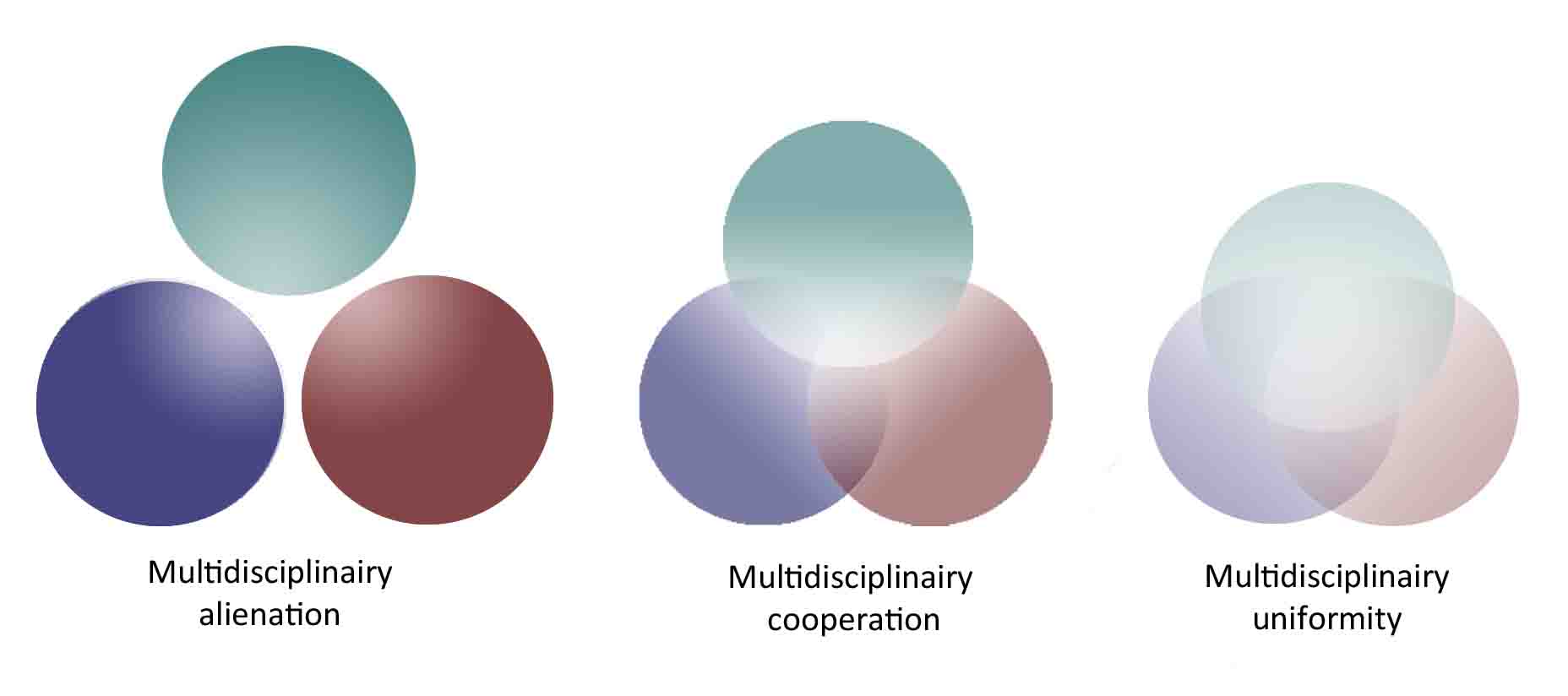 But how different should mindsets be? Learning from each other starts with understanding each other and this requires an overlap in frames of references. But learning starts when frames from different people are compared with each other. So too small differences (on the right side of the illustration) create too little learning possibilities and mutual challenges of ideas. The three participants do not introduce enough difference to make the group challenge each other's ideas. Too big differences (left in the illustration) create mutual misunderstanding, there is not enough common ground. Multidisciplinary teams that agree on the targets and have the same basic values and a certain amount of shared expertise, but at the same time can deliver a frame of reference from their different professions, probably have the best opportunity to create the highest results together.
But how different should mindsets be? Learning from each other starts with understanding each other and this requires an overlap in frames of references. But learning starts when frames from different people are compared with each other. So too small differences (on the right side of the illustration) create too little learning possibilities and mutual challenges of ideas. The three participants do not introduce enough difference to make the group challenge each other's ideas. Too big differences (left in the illustration) create mutual misunderstanding, there is not enough common ground. Multidisciplinary teams that agree on the targets and have the same basic values and a certain amount of shared expertise, but at the same time can deliver a frame of reference from their different professions, probably have the best opportunity to create the highest results together.
8. Learning from each other
If we want to analyze the principles behind learning from each other, we can best discuss the difference between coaching and advising. Suppose somebody hires an advisor for solving a problem he cannot solve himself and suppose the problem is due to a blockade in the frame of reference and not a result of a lack of competences. An advice is a product that originates from the mindset of the advisor. Such an advice will work well if the advisor can execute the advice. But what happens if the advice asker has to execute the advice which does not originate from his own frame of reference? The advice can be regarded as an organ donation with a big chance of rejection. As long as the advise can be fully executed according to the original plan, it might be a successful operation. But as soon as the implementation has to be adjusted, because things develop in an unexpected way, the executer will have to fall back on his own frame of reference in order to adjust the advice to the new circumstances. In this case we get a mix of mindsets combined in one project which usually doesn't work well. Probably the adjusted approach will include parts of both mindsets and confusion will be the biggest result. The project plan is not embedded in one coherent frame of reference. In many instances such projects are cancelled somewhere in an undefined way. You might question yourself whether this theory states that advices should not be asked? No, there are successful ways the implement advices from external consultants, as long as there is a strong overlap between the frame of reference of the adviser and the one who asks the advice.
 Coaching differs from advising in the sense that a good coach helps the coachee to become aware of his implicit mental models. By doing this, the coachee can gain a deeper insight in why he defined the problem in such a way and which possible solutions were blocked by doing that. This creates opportunities for the coachee to adjust his own mindset and to enlarge the repertoire of possible solutions. These solutions are a product of the own mindset and have high chances that they can be implemented successfully. The added value of a good coach is not to solve the problem of the coachee, but to create a dialogue in which the coachee can create different perspectives on reality and by doing that create opportunities for different results. The changed frame of reference of the coachee will take care that there arise new options to solve the problem. These options are fully integrated in the changed frame or reference and a high chance of being successful.
Coaching differs from advising in the sense that a good coach helps the coachee to become aware of his implicit mental models. By doing this, the coachee can gain a deeper insight in why he defined the problem in such a way and which possible solutions were blocked by doing that. This creates opportunities for the coachee to adjust his own mindset and to enlarge the repertoire of possible solutions. These solutions are a product of the own mindset and have high chances that they can be implemented successfully. The added value of a good coach is not to solve the problem of the coachee, but to create a dialogue in which the coachee can create different perspectives on reality and by doing that create opportunities for different results. The changed frame of reference of the coachee will take care that there arise new options to solve the problem. These options are fully integrated in the changed frame or reference and a high chance of being successful.
9. Summary: Changing mindsets, changing results
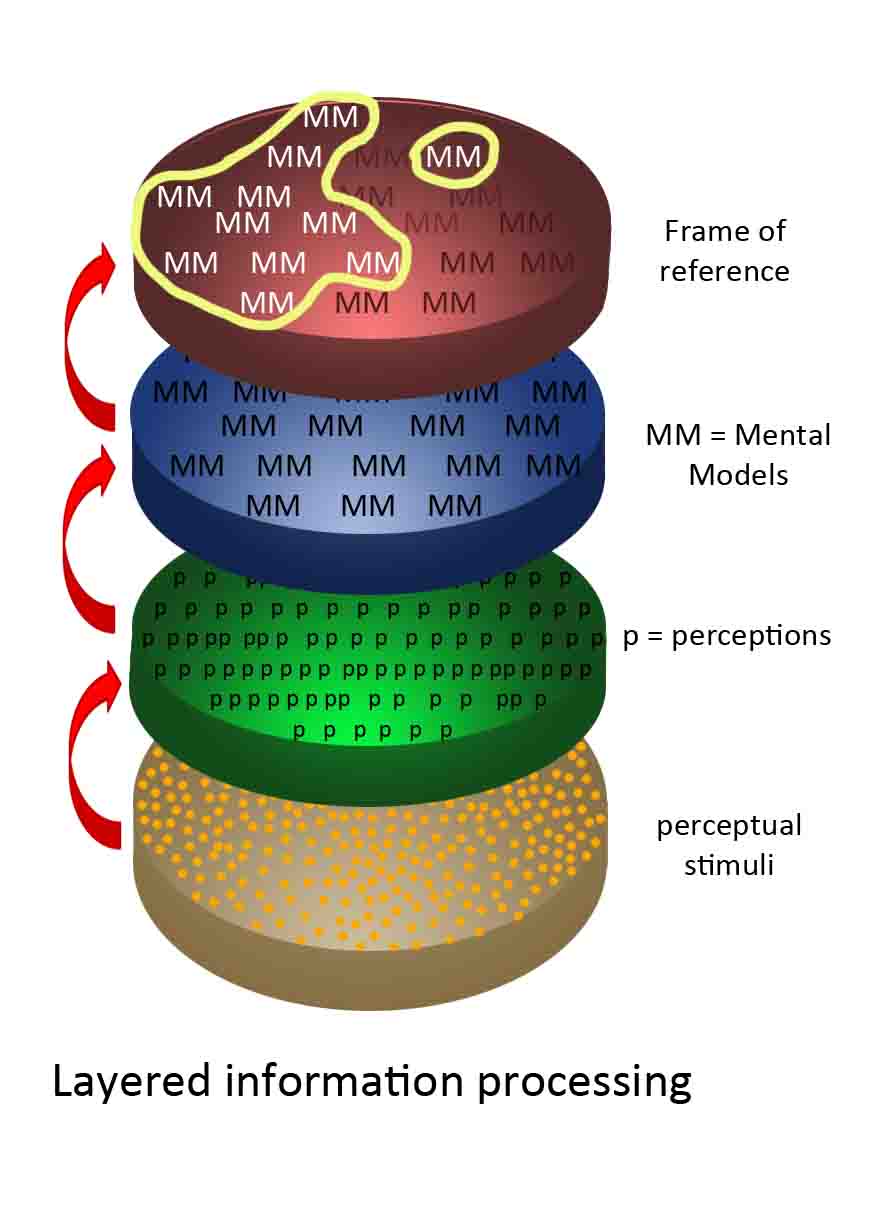 The analysis of perception learns us that we can digest a lot of information by being very selective. We give meaning to distilled patterns through the process of recognition. In our thinking and our way of understanding the world, we give meaning based on a selection of models which we have in mind. What we call thé reality is in fact our personal reality. The way this reality is defined helps us to understand the world and to solve complex problems. If we don't manage to solve them, there might be a shortage of competences, but usually it is due to our selection of mental models. If we can challenge our own assumptions, with or without an external party, and can change the way we define the world, we can free blocked opportunities en create results which used to be out of reach.
The analysis of perception learns us that we can digest a lot of information by being very selective. We give meaning to distilled patterns through the process of recognition. In our thinking and our way of understanding the world, we give meaning based on a selection of models which we have in mind. What we call thé reality is in fact our personal reality. The way this reality is defined helps us to understand the world and to solve complex problems. If we don't manage to solve them, there might be a shortage of competences, but usually it is due to our selection of mental models. If we can challenge our own assumptions, with or without an external party, and can change the way we define the world, we can free blocked opportunities en create results which used to be out of reach.
Juni Daalmans
Daalmans Organizational Development
November 2010